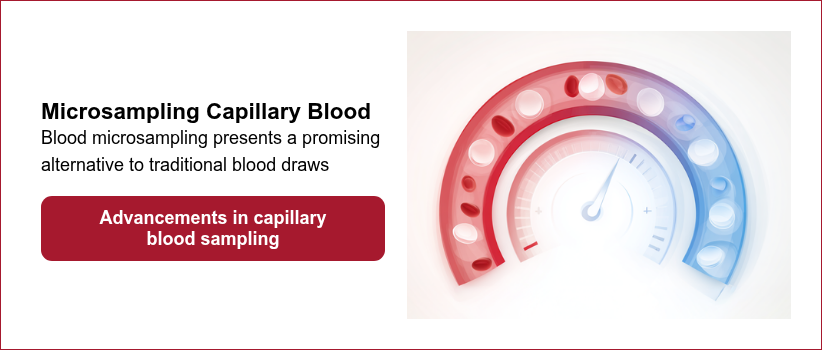Share this
Blood Sampling Without Needles: Addressing the Challenges of Traditional DBS
by Neoteryx Microsampling on Jun 29, 2017 9:09:00 AM
Blood microsampling is transforming the way healthcare providers, researchers, and patients think about blood collection.
Traditional dried blood spot (DBS) sampling methods, while revolutionary in their time, can be affected by variables such as hematocrit; the percentage of red blood cells in the blood, which may adversely impact test results.
New advances in fingerstick blood testing and microsampling devices offer alternatives that may minimize these challenges, improve patient comfort, and enhance accuracy.
How Fingerstick Blood Testing is Changing Healthcare

The COVID-19 pandemic accelerated the adoption of fingerstick methods for remote blood collection. This approach enables patients to draw their own blood at home, eliminating the need for clinic or lab visits.
A "fingerstick" is a minimally invasive procedure using a lancet to draw a drop or two of capillary blood from a finger. The specimen is then collected on microsampling device, once dried, the sample is mailed to a lab for analysis.
Fingerstick sampling is changing healthcare in several ways:
- Hospital and Clinic Care: Minimizes stress and pain associated with venous blood draws, which can be especially challenging in pediatrics, chronically ill patients, or those with needle anxiety.
- Telemedicine and Telehealth: Blood collection kits mailed to patients support remote monitoring and decentralized trials.
- Personal Health and Wellness: Empowers patients to manage their own health and participate in disease management from home.
- Public Health Studies: Facilitates large-scale population research by allowing at-home blood collection for serology and other studies.
Finger Prick Blood Draws: Are All Lancets Created Equal?
Fingerstick blood draws are generally quicker and more patient-friendly than venous draws. However, the choice of lancet and preparation technique can affect comfort and sample quality.
Lancet Types:
 |
Standard: Exposed-blade lancets go deep into the skin and hit pain nerves, making repeated use painful and risky. |
 |
Safety Lancets: Spring-loaded blades that retract automatically, improving hygiene and reducing anxiety by keeping the blade hidden. |
 |
Vacuum Lancets: Penetrate more shallowly and use vacuum to draw blood, enabling sampling from non-fingertip sites. |
 |
Laser Lancets: Once popular but now largely discontinued due to higher pain and injury risk. |
Preparations to Help Reduce Fingerstick Pain:
- Wash hands with antibacterial soap rather than alcohol wipes to avoid drying and constriction.
- Prick the side of the finger instead of the center for reduced sensitivity.
- Select smaller-gauge or adjustable-depth lancets to fine-tune blood volume versus comfort.
These measures may help improve both the patient's experience and the quality of the sample collected.
The Evolution of Blood Sampling Technology
Blood sampling devices have an interesting history. Since 1947, scientists have been working to enhance the blood collection experience, starting with Vacutainer vacuum tubes and standardized blood collection tubes, and leading to dried blood spot (DBS) sampling.
This evolution has paved the way for today’s innovative technologies, such as Volumetric Absorptive Microsampling (VAMS™), which can help address issues like hematocrit variability.
For participants, traditional blood draws can be an uncomfortable experience, especially when they involve painful needles. Modern microsampling devices offer minimally invasive methods to collect blood without relying solely on venipuncture.
Addressing Hematocrit Challenges with Modern Microsampling
Hematocrit levels, which indicate the proportion of red blood cells in the blood, can significantly impact traditional dried blood spot (DBS) methods, leading to inconsistent results. Variations in hematocrit levels may change the distribution of analytes within a dried spot, complicating the interpretation of biomarkers.
Modern microsampling technologies, such as VAMS™, aim to address these hematocrit-related challenges by allowing for volumetrically precise collection that remains unaffected by changes in blood viscosity or cell concentration. This can provide:
- Volumetric Precision regardless of hematocrit levels.
- Reliable Analysis suitable for therapeutic drug monitoring or clinical diagnostics.
- Streamlined Workflows that reduce variability caused by user technique or environmental factors.
- Enhanced Stability allowing storage and transport of dried samples without refrigeration.
Microsampling: A Precise, Low-Volume Alternative
-1-2-1.jpeg?width=815&height=430&name=collection-Mitra-anywhere-car%20(2)-1-2-1.jpeg)
Microsampling technology allows for the collection of very small blood samples, typically less than or equal to 50 µL. This small volume is still sufficient to assess drug levels, biomarkers, and other clinical parameters. In fact, samples as little as 10–30 µL may be adequate for the analysis of blood, plasma, or serum exposures.
Mitra® microsampling devices provide a reliable and precise way to collect fixed volumes of blood, effectively eliminating the hematocrit-related bias often found in traditional dried blood spot (DBS) sampling. These devices are user-friendly and require minimal training, making them suitable for use in remote settings. Additionally, because dried blood samples do not need cold storage or special biohazard transportation, they help lower costs and simplify logistical processes.
Mitra® is particularly suitable for remote blood collection, featuring native barcoding and resealable bags for added convenience. With less pain and simpler logistics, these devices may improve patient satisfaction and study retention.
A New Era in Blood Collection
From overcoming patient discomfort to solving the hematocrit effect in traditional DBS, blood microsampling technologies like Mitra® with VAMS® represent a leap forward in clinical and research workflows. By enabling low-volume, high-quality sampling in decentralized settings, microsampling can help researchers, clinicians, and public health professionals improve participation, reduce costs, and maintain data quality, all without the logistical burden of traditional venipuncture.
As more real-world studies validate these methods, microsampling may become the new standard for blood collection in diverse fields, from clinical trials to population health.

Share this
- Microsampling (206)
- Research, Remote Research (119)
- Venipuncture Alternative (105)
- Clinical Trials, Clinical Research (83)
- Mitra® Device (73)
- Therapeutic Drug Monitoring, TDM (51)
- Dried Blood Spot, DBS (39)
- Biomonitoring, Health, Wellness (30)
- Infectious Disease, Vaccines, COVID-19 (24)
- Blood Microsampling, Serology (23)
- Omics, Multi-Omics (21)
- Decentralized Clinical Trial (DCT) (20)
- Specimen Collection (18)
- Toxicology, Doping, Drug/Alcohol Monitoring, PEth (17)
- Skin Microsampling, Microbiopsy (14)
- hemaPEN® Device (13)
- Preclinical Research, Animal Studies (12)
- Pharmaceuticals, Drug Development (9)
- Harpera Device (7)
- Industry News, Microsampling News (5)
- Antibodies, MAbs (3)
- Company Press Release, Product Press Release (3)
- Environmental Toxins, Exposures (1)
- July 2025 (1)
- May 2025 (1)
- April 2025 (2)
- December 2024 (2)
- November 2024 (1)
- October 2024 (3)
- September 2024 (1)
- June 2024 (1)
- May 2024 (1)
- April 2024 (4)
- March 2024 (1)
- February 2024 (2)
- January 2024 (4)
- December 2023 (3)
- November 2023 (3)
- October 2023 (3)
- September 2023 (3)
- July 2023 (3)
- June 2023 (2)
- April 2023 (2)
- March 2023 (2)
- February 2023 (2)
- January 2023 (3)
- December 2022 (2)
- November 2022 (3)
- October 2022 (4)
- September 2022 (3)
- August 2022 (5)
- July 2022 (2)
- June 2022 (2)
- May 2022 (4)
- April 2022 (3)
- March 2022 (3)
- February 2022 (4)
- January 2022 (5)
- December 2021 (3)
- November 2021 (5)
- October 2021 (3)
- September 2021 (3)
- August 2021 (4)
- July 2021 (4)
- June 2021 (4)
- May 2021 (4)
- April 2021 (3)
- March 2021 (5)
- February 2021 (4)
- January 2021 (4)
- December 2020 (3)
- November 2020 (5)
- October 2020 (4)
- September 2020 (3)
- August 2020 (3)
- July 2020 (6)
- June 2020 (4)
- May 2020 (4)
- April 2020 (3)
- March 2020 (6)
- February 2020 (3)
- January 2020 (4)
- December 2019 (5)
- November 2019 (4)
- October 2019 (2)
- September 2019 (4)
- August 2019 (4)
- July 2019 (3)
- June 2019 (7)
- May 2019 (6)
- April 2019 (5)
- March 2019 (6)
- February 2019 (5)
- January 2019 (8)
- December 2018 (3)
- November 2018 (4)
- October 2018 (7)
- September 2018 (6)
- August 2018 (5)
- July 2018 (8)
- June 2018 (6)
- May 2018 (5)
- April 2018 (6)
- March 2018 (4)
- February 2018 (6)
- January 2018 (4)
- December 2017 (2)
- November 2017 (3)
- October 2017 (2)
- September 2017 (4)
- August 2017 (2)
- July 2017 (4)
- June 2017 (5)
- May 2017 (6)
- April 2017 (6)
- March 2017 (5)
- February 2017 (4)
- January 2017 (1)
- July 2016 (3)
- May 2016 (1)
- April 2016 (2)


Comments (9)